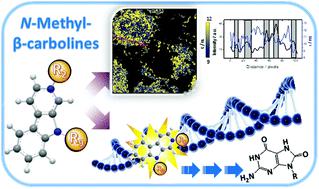当前位置:
X-MOL 学术
›
Org. Biomol. Chem.
›
论文详情
Our official English website, www.x-mol.net, welcomes your
feedback! (Note: you will need to create a separate account there.)
N-Methyl-β-carboline alkaloids: structure-dependent photosensitizing properties and localization in subcellular domains.
Organic & Biomolecular Chemistry ( IF 2.9 ) Pub Date : 2020-07-01 , DOI: 10.1039/d0ob01122c M Paula Denofrio 1 , Federico A O Rasse-Suriani 2 , Jose M Paredes 3 , Federico Fassetta 1 , Luis Crovetto 3 , Maria D Giron 4 , Rafael Salto 4 , Bernd Epe 5 , Franco M Cabrerizo 1
Organic & Biomolecular Chemistry ( IF 2.9 ) Pub Date : 2020-07-01 , DOI: 10.1039/d0ob01122c M Paula Denofrio 1 , Federico A O Rasse-Suriani 2 , Jose M Paredes 3 , Federico Fassetta 1 , Luis Crovetto 3 , Maria D Giron 4 , Rafael Salto 4 , Bernd Epe 5 , Franco M Cabrerizo 1
Affiliation

|
N-Methyl-β-carboline (βC) alkaloids, including normelinonine F (1b) and melinonine F (2b), have been found in a vast range of living species playing different biological, biomedical and/or pharmacological roles. Despite this, molecular bases of the mechanisms through which these alkaloids would exert their effect still remain unknown. Fundamental aspects including the photosensitizing properties and intracellular internalization of a selected group of N-methyl-βC alkaloids were investigated herein. Data reveal that methylation of the βC main ring enhances its photosensitizing properties either by increasing its binding affinity with DNA as a biomolecular target and/or by increasing its oxidation potential, in a structure-dependent manner. As a general rule, N(9)-substituted βCs showed the highest photosensitizing efficiency. With the exception of 2-methyl-harminium, all the N-methyl-βCs investigated herein induce a similar DNA photodamage profile, dominated largely by oxidized purines. This fact represents a distinctive behavior when comparing with N-unsubstituted-βCs. On the other hand, although all the investigated compounds might accumulate mainly into the mitochondria of HeLa cells, methylation provides a distinctive dynamic pattern for mitochondrial uptake. While rapid (passive) diffusion is most probably reponsible for the prompt uptake/release of neutral βCs, an active transport appears to mediate the (reatively slow) uptake of the quaternary cationic βCs. This might be a consequence of a distinctive subcellular localization (mitochondrial membrane and/or matrix) or interaction with intracellular components. Biomedical and biotechnological implications are also discussed herein.
中文翻译:

N-甲基-β-咔啉生物碱:结构依赖性光敏特性和亚细胞域定位。
N-甲基-β-咔啉 (βC) 生物碱,包括去甲素 F ( 1b ) 和去甲素 F ( 2b ),已在多种生物物种中发现,发挥着不同的生物学、生物医学和/或药理学作用。尽管如此,这些生物碱发挥作用的机制的分子基础仍然未知。本文研究了一组选定的N-甲基-βC 生物碱的基本方面,包括光敏特性和细胞内内化。数据显示,βC 主环的甲基化通过增加其与作为生物分子靶标的 DNA 的结合亲和力和/或通过以结构依赖性方式增加其氧化电位来增强其光敏特性。一般来说, N (9)-取代的βCs表现出最高的光敏效率。除 2-甲基-铷之外,本文研究的所有N-甲基-βC 都会诱导类似的 DNA 光损伤特征,主要由氧化嘌呤主导。与N-未取代-βC 相比,这一事实代表了一种独特的行为。另一方面,尽管所有研究的化合物可能主要积聚到 HeLa 细胞的线粒体中,但甲基化为线粒体摄取提供了独特的动态模式。虽然快速(被动)扩散很可能是中性 βCs 迅速摄取/释放的原因,但主动转运似乎介导了四元阳离子 βCs(相对较慢)的摄取。这可能是独特的亚细胞定位(线粒体膜和/或基质)或与细胞内成分相互作用的结果。 本文还讨论了生物医学和生物技术的影响。
更新日期:2020-08-26
中文翻译:

N-甲基-β-咔啉生物碱:结构依赖性光敏特性和亚细胞域定位。
N-甲基-β-咔啉 (βC) 生物碱,包括去甲素 F ( 1b ) 和去甲素 F ( 2b ),已在多种生物物种中发现,发挥着不同的生物学、生物医学和/或药理学作用。尽管如此,这些生物碱发挥作用的机制的分子基础仍然未知。本文研究了一组选定的N-甲基-βC 生物碱的基本方面,包括光敏特性和细胞内内化。数据显示,βC 主环的甲基化通过增加其与作为生物分子靶标的 DNA 的结合亲和力和/或通过以结构依赖性方式增加其氧化电位来增强其光敏特性。一般来说, N (9)-取代的βCs表现出最高的光敏效率。除 2-甲基-铷之外,本文研究的所有N-甲基-βC 都会诱导类似的 DNA 光损伤特征,主要由氧化嘌呤主导。与N-未取代-βC 相比,这一事实代表了一种独特的行为。另一方面,尽管所有研究的化合物可能主要积聚到 HeLa 细胞的线粒体中,但甲基化为线粒体摄取提供了独特的动态模式。虽然快速(被动)扩散很可能是中性 βCs 迅速摄取/释放的原因,但主动转运似乎介导了四元阳离子 βCs(相对较慢)的摄取。这可能是独特的亚细胞定位(线粒体膜和/或基质)或与细胞内成分相互作用的结果。 本文还讨论了生物医学和生物技术的影响。











































 京公网安备 11010802027423号
京公网安备 11010802027423号